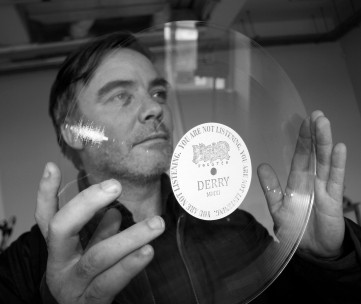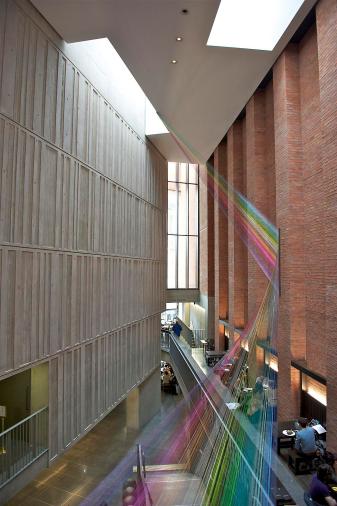
Mark Garry
Mullingar native, Mark Garry is a talented artist that I have respected and looked up to for a long time. I met him first when his show A Winter Light was being shown in The Model. At the time I was not even a year out of college, and my job was to sit and watch over parts (and make sure nothing got broken) of the exhibition. ‘But regardless Mark was still genuine and friendly, answering questions, even complimenting my choice of reading material while on the job’ (Stillness and Speed by Dennis Bergkamp, if you were curious). I will always be grateful for the generosity and respect he demonstrated towards me as someone starting out in the art world I hope you enjoy this interview as he is a great artist with some great ideas.
Let’s start first with North of the West, which recently became part of the IMMA collection.
North of the West was part of a series of works that kind of looks at the sea – its cultural impact and its social impact. I suppose it stems from a project called Drift, which ended up being a performance and film project which was played out in Detroit and Sherken Island off West Cork. I worked on Drift with a composer called Sean Carpio, we have collaborated a lot. We agree on a lot of things, but disagree on enough things for the creative relationship to be interesting for us both. We don’t really recognise a divisions in cultural genres.

Drift (2012)
With Drift, I was interested in the way that our cultural, historical and day to day relationship with nature. Since the beginning of the Industrial age we have felt the need to dominate nature both philosophically and physically, but when you live on an island you have a much more respectful reciprocal relationship with nature. Nature also dictated the aesthetic/performative encounter with this work . We attached an Aeolian harp,(a harp played by the wind) on to a traditional wooden sailboat and located this instrument in the centre of a space called horseshoe bay , which is a beautiful natural amphitheatre, we located a brass quartet and a solo saxophone player on the shore and these instruments performed with the wind harp using a form of improvised orchestration. The piece itself was based on a series of translations of a Sumerian hymn, the first documented song, and they again relate to nature. Sean and I were also commissioned to release a 10” vinyl from this project.

Drift (2012)
North of the West was a film work that was also concerned with island life – the ways in which living on an island and this isolation makes it easy to control your surrounding environment, and I guess that’s what the Catholic Church did in Ireland for sixty, seventy years. That work was about my relationship with religion as a kid: something being majestic and beautiful, but also terrifying. So the sea acts as an analogy for that.
There are some really direct references to Japanese culture, which I’m really interested in, and in particular in a movement called Mono-ha, which is a short-lived 1960’s Japanese land art movement. It was really interesting to me, the idea of something that was deeply embedded within thinking, and craft, and nationhood. How they all become kind of intertwined. I’ve never been, but Japanese culture is definitely had a significant impact on my work.
Sean and I tried to compose a new musical soundtrack for piece for North of the West, and while Sean and I were trying to figure out the composition for it, Sean suggested that we try Drift, and they both just seemed to work together. It just seemed to make sense in the end, and it was kind of a nice way to revisit an old work.

North of the West (2017)
It’s interesting how interactive the piece is.
Yes with this work there is a record player with a record located close to the film and the audience gets to decide whether to have a soundtrack or not. I suppose I was trying to encourage a less passive encounter. That’s why I’m interested in installation art, as an opportunity to interact with spaces in a non-passive way. Essentially, where you as an audience member are the activator of an artwork. With North of the West, we literally become an activator of the work – you make the decision of whether you listen to the accompanying music or not, you decide when the music comes in… That one decision adds complexity to how we experience things. it is a very open work in that sense.
Music is a recurring aspect of your work – can you touch on that a bit more, what are you listening to ?
Music and listening play a large part of how I think, in some ways a bigger part than visual art.
I’m listening to a lot of Donald Bird at the moment. I’m also listening to Frank Ocean, and Ithink the things currently happening in hip-hop are very interesting! Then there’s this Scottish classical composer that I really like called Anna Meredith, who is making really beautiful, interesting music. And a guy from another island, Jersey! He’s called Mura Masas – beat-driven music.
I have an extensive vinyl collection, and am a bit fetishistic about music. The way we listen to recorded music has change quite dramatically over the past twenty years. The quality is very different, we listen to stuff on our phones through tinny speakers at a compressed rate, and you don’t get the nuance or the particularities where you hear something on vinyl… you get a much more visceral physical encounter. When you listen to something on your phone, it is wholly separated from the initial idea that created the music. You have this ‘removed’ kind of digital experience, whereas with a record you can actually see and hear from an acoustic perspective how it’s actually happening, and how the sound is created.
Let’s talk about some of your collaborative work, as that often has musical elements to it.
I have made a whole series of collaborative music projects with a small core group of people – Eileen Carpio, Sean Carpio, Nina Hinds, Karl Burk, Fabien Leseure, and myself. We started as a group called A= Apple. Nina and Karl and myself were the starting point, and then Fabien joined.
We as a group respond to different sets of conceptual criteria/material with each new project; it’s quite a simple setup, in a sense that we go to a gallery space or a non-conventional studio space, and convert it to become a studio for a short amount of time. Each person brings a number of their own responses to that conceptual material, and then as a group, we basically expand on those responses. It really requires an awful lot of generosity from one participant to the other. Depending on the location, we also usually invite musicians from the local community to come and collaborate with us.
A Winters Light was recently released as a record – would you like to talk about that?

A Winter Light Album cover (2018)
A Winter Light was kind of different, in the sense that it was responding to a show of mine rather than something outside of the group. With that show while I was developing the exhibition I sent the participants small sections of pieces I was reading, or pieces I was developing, or things I was thinking about and this may have subtly impacted there responses.
With A Winter Light, we invited Claudia Shwab, Oliver Acorn, Robert Stillman, and Pádraig and Cillian Murphy to come become participants. We invite other people to become part of it, and it’s kind of amazing how people are just so generous with their time and energy. And their talents! It got released by Blue Stack Records, which is a small label in Sligo as well. So, it was very northwest based.

A Winter Light (2014)
Research seems to drive a lot of your work. Can you go into that a bit more?
My practice is both research-driven and process-driven. While there are consistent methodologies in the work each particular exhibition responds to a new set of conceptual criteria. This is often site responsive, in the sense that I will be invited to make an exhibition somewhere in the world and will try and respond to some political, social, historical element of that local society. But the outcome of the work is never dictated before the exhibition – there are always things left open, and elements are developed throughout the installation.
I did a project in Charleston South Carolina called “We Cast Shadows”, Charleston and integrated a number of historical and socio political elements such as its relationship with the slave trade.
That being said they are not always overtly site/situation responsive , other than being architecturally responsive. I am doing a project in The Mac in Belfast next year called “Songs of the soil“ that broadly has to do with the relationship between Landscape and Song.
Let’s talk about your string works.
So, my string works are constructed to suit each space, and it depends on the

The Permanent Present
(2012)
architecture of that space or the light of the space, or just the place that space is in, within the country or the world. So for example, in a bright spot I make darker work, and with darker areas I do lighter work. It’s just finding how to activate that specific space at that particular time. But also, to kind of activate the higher spaces in a gallery which we aren’t usually interested in. Those spaces that aren’t the walls, the spaces in between. The space that you don’t really notice because they are generally not activated. I suppose the way the string works are set up optically, they transform as you move around them so you again can’t have a passive relationship with them.You’re a participant in the work. And I hope they act as a marriage of spectacle and empathy. I recognise a strength is subtlety and quietness.
You can find out more about Marks’s work through the website links below
http://www.kerlingallery.com/artists/mark-garry/artist_works
you can buy/stream A Winter Light below
http://www.bluestackrecords.com/a-winter-light-1/
thank you Adrian Mc Hugh for your work editing
You can support Painting in Text through Patreon, link below
https://www.patreon.com/PaintinginText

Hi there. Thank you for your great content. That’s it:)
LikeLike